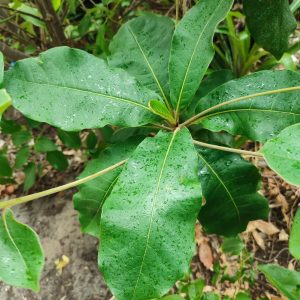Terminalia catappa
Indian almond, West Indian almond, sea almond
Origin
Native to south east Asia and now distributed in coastal areas throughout the warm tropics.
Climate
It is a tropical/near-tropical species growing in humid areas with mean annual temperatures and precipitation of 15-35°C and 75-3000mm respectively. It will grow up to 1200m altitude in the tropics and can not withstand frosts.
Plant Description
A medium to large deciduous tree, 12-25m high with grey-brown bark and whorls of almost horizontally tiered pagoda-like branches 1-2 m apart. Alternate glossy and coriaceous simple and entire obovate leaves clustered towards branch tips on short petioles are large, 15-25cm long and 8-15cm wide, dark green above and a lighter colour underneath. With senescence the leaves turn eye-catching colours of yellow, red or dark red, scarlet or dark purple before falling.
Relatives
Indian almond is in the Combretaceae family consisting of 18 genera and about 450 species. Kakadu plum is an Australian bush food in the same genus.
Soils
Undemanding óf soil type and pH. Sands and sandy loams are preferred but it tolerates heavier clay soils provided there is still good drainage, and soil pH can be from strongly acid through to alkaline limestone. It can also grow in saline soils and in coastal areas where there may be salt spray.
Propagation
Seeds maintain viability for lengthy periods, and these are the main means of propagation after being soaked in water for 24 hours before sowing; hypogeal germination may then take 1-3 months.
Cultivars
Although there has been some selection for larger-fruited varieties by indigenous communities, no generally recognised cultivars have been named. Breeding could see substantial improvements in fruit quality and yield.
Flowering and Pollination
Inflorescences are slender spikes 8-16cm long arising from the axil of spur shoot leaves. The small individual apetalous greenish-white flowers appearing in spring are andromonoecious and have 5 white to yellow pubescent calyx lobes with usually ten whitish stamens 2-2.5mm long and yellow anthers. Distal flowers are male with no pistil and proximally there is a lesser number (occasionally none) of hermaphrodite epigynous and 2 ovule unilocular flowers; in the latter, a nectiferous disk with sugary secretions surrounds the style. Flowering does not occur when the tree is defoliated, and the ratio of male to hermaphrodite flowers is about 16:1. Each flower is self-incompatible with various insects being the cross-pollination vectors; only 1 of the 2 ovules is fertilized. Fruit seeds are naturally distributed by fruit bats and birds, and they also have sufficient buoyancy to be carried over long distances by rivers and oceans without losing viability.
Cultivation
Indian almond can be planted in full sun or light shade. Seedling growth is initially slow but maximised when fertile potting mixes are used. Weeding may be necessary for a few months following in-ground transplanting. Thereafter the plant can then become quite fast-growing under ideal conditions. A pre-plant fertilizer mix should be added to poor soils, allowing sufficient time for incorporation. Regular fertilizing and mulching is recommended for fruiting plants.
Wind Tolerance
Given its preferred habitat of coastal areas, it is not unexpected that it has good wind tolerance.
Pruning
Minimal, but size containment may need addressing and long drooping branches may need to be shortened. If pruned too hard when young it may take some time to recover.
The Fruit
The hard, green-to-reddish indehiscent drupaceous fruit varies markedly in size, shape and colour but commonly is ovate, up to 4-7cm long and 2.5-4cm wide, weighing about 40g. It has a slightly flattened shape with two stubby lengthwise protruding ridges or wings. As it matures and ripens, it turns from green to yellow or reddish. The cylindrical kernel is surrounded by a 3-6mm layer of green flesh (exocarp), a tough and fibrous corky husk (mesocarp) and a thick, hard, often pitted, stone (endocarp). it contains 19-25% protein, 55% lipid, principally palmitic and oleic acids, 15% carbohydrate and is a good source of Ca and Fe.
Fruit Production and Harvesting
The juvenility period before commencement of flowering with seedlings is 3-4 years. Mature plants fruit prodigiously, and harvesting usually involves gathering fallen fruit in late summer. After collection, the thin flesh and husk should be stripped off and the nut allowed to dry for some weeks. As with macadamia nuts, the kernel is then more easily separated from the shell. A good nut cracker (or hammer) will be necessary to break the shell.
Fruit Uses
The fleshy fruit exocarp can be eaten but is not very tasty. The kernel is the main edible product with a flavour similar to almonds; it can be eaten raw or roasted.
Pests and Diseases
These are minimal in its native areas. However, destruction of leaves by a butterfly caterpillar (Petrelaea) has been reported in tropical Australia, and other defoliating insects such as grasshoppers and beetles plus thrips may cause problems.
Comments
This is essentially a tropical species favouring consistent warm temperatures and substantial precipitation. However the fact that it can grow in almost all soil conditions with precipitation down to 750mm pa suggests that it could grow here in the south west of WA. It can produce considerable quantities of fruit when mature, so unless harvested and well-managed, there could be a litter problem from fallen fruit and leaves. Extracting the kernel from the fibrous husk can be difficult.
